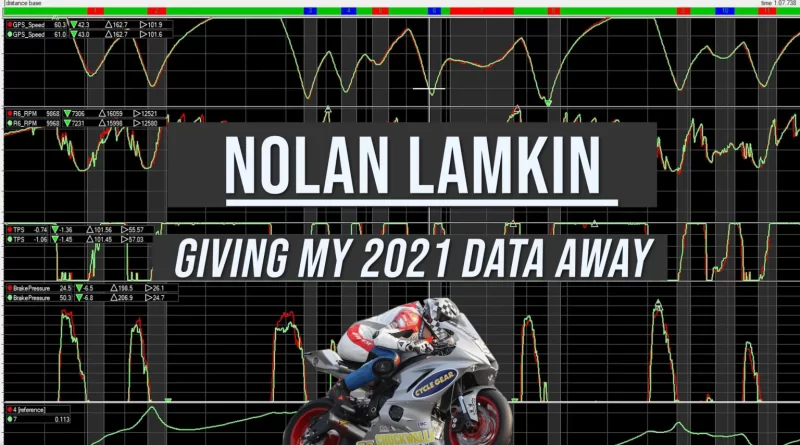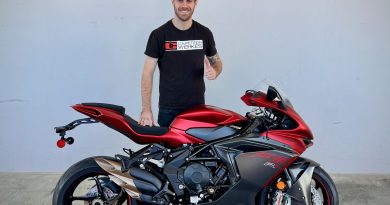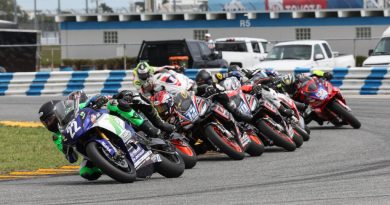Nolan Lamkin: Give It Away, Give It Away, Give It Away Now
A little over a year ago, Supersport rider Nolan Lamkin shared his insights and the data that he had learned and gathered during the 2020 MotoAmerica Supersport Championship. Well, the always benevolent Indianapolis native is back again to share his takeaways (and, yes, data) from his 2021 MotoAmerica Supersport season:
2021 was my first MotoAmerica Supersport year racing the 2017+ version of the Yamaha YZF-R6. In previous years, I had ridden the 2008-16 Yamaha R6, which has different electronics, different front suspension, different bodywork, and more. In 2021, I got a top-five finish and even got on the podium so, overall, the 2017+ R6 felt much more comfortable for me. It’s a great overall package, and here are my thoughts on the bike, along with a discussion of some things that changed during the 2021 Supersport season.
DATA
First off, here is my data from 2021. I had previously given away my data from 2020, and I want to keep this going. At 20 years old, I still have never seen another rider’s data, so if some other kid could use my data to help them develop as a rider, I think that is amazing! I included data from when I got on the MotoAmerica podium and also when I got in the top five at New Jersey Motorsports Park. I picked races to share that were important, not giving away something meaningless like a Free Practice, but actually in important races against other people. I also included a track day at Chuckwalla Valley Raceway during preseason training on my old R6.
We used an AIM Evo 5 system from Superbike Unlimited, which worked great! The new R6 has so many more channels through the ECU than the 2008-16 R6 does.
ELECTRONICS
Wheelie Control
The biggest thing for me to understand about the 2017+ R6 electronics was the wheelie control. Getting used to wheelie control was so weird because we ran a YEC ECU, and the wheelie/lift control only works at 100% throttle. If I rolled off the throttle, then the front wheel would be pointed at the sky. But for me, it wasn’t just the front wheel lifting, that would cause me to roll out of it during the first weekend of testing, but feeling like the bike was going to wheelie. Where the front forks would be extending (like it was about to wheelie) but the front wheel was still on the ground, and instinctively, I would start to manage the wheelie but that would turn the wheelie control off. So, me starting to manage it would make the bike wheelie instead of trusting the electronics. Once I fully learned to hold it wide open, it was like a mental switch, and I got it. At certain tracks and times, you can see how my throttle trace would go wide open, instead of modulating it more, and the front wheel didn’t lift. It’s only a 600, so the wheelie wasn’t everywhere, it was only at a few specific places across the MotoAmerica calendar. Michelin Raceway Road Atlanta is a hard track to program wheelie control just because the track falls away from you in a couple of places, so the bike naturally will want to wheelie, and you can’t pull too much power out of the bike for the wheelie, or you start losing acceleration. Turn 11 at Ridge Motorsports Park in Washington was another place where it was difficult to program wheelie control.
Traction Control
TC is much harder for me to quantifiably describe and articulate how it felt. Normally, I would start a race in TC Mode 2, and then finish in Mode 3 or 4, but that was just a feeling with how the bike was sliding and how the bike felt, or if it felt like the ECU was pulling too much power out, and I couldn’t accelerate properly.
ERGONOMICS
Seat
The 2017+ R6 is an incredibly comfortable bike for me to ride. We ran Sharkskinz bodywork and a seat tray. The detachable seat tray was crucial for us. We had 3/4-inch risers made for my seat to raise me up and to get my legs in a better position. Using the SharkSkinz seat tray, we were able to mount the seat using 4 bolts, instead of having the seat tray fit underneath the gas tank in the front.
Tuck
My tuck was incredible. I consistently had fast trap speeds, with me being 6’2″ because my tuck is super tight, and the new R6 allows me to get fully tucked in. We ran a Zero Gravity double bubble windscreen, which worked great. For me, the 2017+ R6 has a much tighter tuck compared with the 2008-16 R6.
SUSPENSION
We ran the front suspension really soft. On the 2008-16 R6, we normally ran around 95 in the front. For the rear spring, we ran the same as the 2008-16 R6. But, for the front springs, we ran multiple rates softer. The front forks are ~25mm longer on the 2017+ R6 compared with the 2008-16 iteration, so when we ran stiff front springs, the front end was super high during braking, and I couldn’t get the bike to turn into the corner. We had had some people earlier in the season say I needed to run a certain spring rate in my front forks, but it made the bike almost impossible for me to ride. Way too stiff. Not that it was a bad setting, but for me, it was not what I needed. Once we found a setting, we barely changed anything. We left WeatherTech Raceway Laguna Seca and only changed gearing for New Jersey Motorsports Park, and then, after race one at NJMP, we added 2mm of rear ride height. That’s it.
COOLING
We started preseason testing with the OEM upper radiator and running the SharkSkinz lower, which is completely filled in. But, we had some issues with overheating, so we added a lower radiator and cut out the lower to be open. We also ran a radiator shroud, which helps with aerodynamics and cooling; you force all of the air through the radiator instead of the air going in random places. We also ran the OEM breather tube that connects the water pump to the back of the cylinder head. We tried running vacuum plugs, but we settled on running the OEM breather tube to eliminate worrying about creating air pockets in the cooling system.
TIRE WARMERS
We also changed our tire warmers and went to CapIt Tire Warmers from Superbike Unlimited for the 2021 season. The previous warmers we had didn’t have the heating elements going all the way to the edge of the tires. Using the CapIt Warmers kept the tire temperatures consistent with what we had on the track. We also used the CapIt Ventostop Wheel Covers/Wind Stop Set that wrap around the wheels and warmers and help keep everything contained. I can’t quantifiably say how much they helped, but we liked them. The CapIt Tire Warmers themselves were great, and we were glad we changed.
The post Nolan Lamkin: Give It Away, Give It Away, Give It Away Now appeared first on MotoAmerica.




